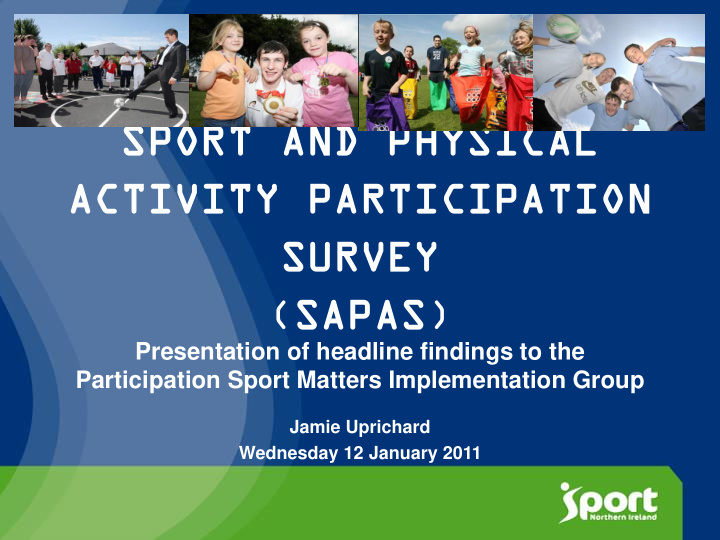



SPORT ORT AND PHYSICAL YSICAL ACTIVI TIVITY TY PARTIC RTICIPAT IPATION ION SURVEY RVEY (SAPAS PAS) Presentation of headline findings to the Participation Sport Matters Implementation Group Jamie Uprichard Wednesday 12 January 2011
OV OVERVIEW ERVIEW • Rationale • Methodology • Key Findings – Recommended Level of Physical Activity • Gender • Moderate intensity time per domain • Sports participation – Motivators – Coaching – Club membership • Re-Cap of Headline Findings • Next Steps
RA RATI TIONALE ONALE (1 (1) • Since 2006, DCAL/SNI have worked to draft Northern Ireland’s Strategy for Sport - “Sport Matters” • “Sport Matters” includes targets associated with ‘driving up participation’ and highlights the need for a robust research/ evaluation framework “ By 2009, to have agreed and commenced implementation of a revised research framework for participation rates that is cognisant of the recommendations of the Chief Medical Officers[1] (CMO) in the UK”. PA1 • Limited attempts to measure participation rates of adults - no robust baseline of participation rates • Previous and current surveys do not provide data relating to the intensity, frequency and duration of participation (with the exception of the Health and Well-being Survey 2001 & 2006); and • Lack of bespoke research relating to measuring the CMO’s guidelines for physical activity. [1] The CMO recommends that for general health benefit, adults should achieve a total of at least 30 minutes a day of at least moderate intensity physical activity, on five or more days of the week.
RA RATI TIONALE ONALE (2 (2) • SAPAS – Largest bespoke physical activity survey since 1994 – Inter-agency steering group – £340,000 investment – Ipsos MORI appointed • Overall aim:- “To provide statistically robust data on participation , club membership, volunteering, coaching attitudes to sport and spectating amongst a representative sample of Northern Ireland adults (16+) in order to reliably enhance our understanding of sport and physical activity patterns and determinants across the population”.
SUMMAR ARY Y OF METHODO ODOLOGY LOGY 1. Sample = all adults (16+) living in Northern Ireland; 2. 4653 interviews over 12 months (including boosted samples for Belfast and L/Derry); 3. Survey conducted face to face, in-home, using CAPI approach ; 4. A stratified random sampling approach was applied for selection of households; 5. Respondents within households selected using ‘last birthday rule’ ; and 6. Questionnaire subjected to cognitive testing and piloting (n=100).
ME MEAS ASURING URING PH PHYS YSICAL ICAL AC ACTI TIVITY VITY 4 DOMAI MAINS, NS, 53 PRE-COD CODED D ACTIVITIES TIVITIES
% OF ADU % OF ADULT LTS S AC ACHI HIEVING EVING TH THRE RESHO SHOLD LD
PR PRIO IORITY RITY GR GROU OUPS PS
AG AGE E GR GROU OUP
GE GEND NDER ER
SP SPOR ORTS TS PA PART RTICIPAT ICIPATION ION
MO MOST ST PO POPU PULAR LAR SP SPOR ORTS TS
MOTIVA VATORS TORS
CO COAC ACHING HING
CL CLUB UB ME MEMB MBERSHI ERSHIP
RE RE-CAP CAP - HE HEAD ADLINE LINE FI FIND NDINGS INGS • 35% of Northern Ireland’s adult population achieve the recommended amount of physical activity; • On average, people are active for ~ 8 hrs (487 min.) / week; • Most of the total time stems from the home (183 min.) and work (151 min.); • Women are significantly less active than men (402 min. compared to 576 min.); • People with disabilities and older people are least active among all analysed groups; • 23% of all adults are a member of a club. The proportion of men being a member of a club is double that of a women (31% / 15%); • 36% participated in sport in the last 7 days; • The main reasons for doing sport are ‘just to enjoy it’ and ‘to keep fit’; • Only 8% are aware of the Chief Medical Officer’s recommendation.
NEXT STEPS • Draft final report considered by Project Steering Group (December 2010); • Final report to be published (March 2011); • SAPAS data used to establish baselines, targets and measure progress of “Sport Matters”; • Department of Health proposed SAPAS as ‘surveillance/monitoring’ tool for the Obesity Prevention Strategy (currently out for consultation); and • Further analysis of SAPAS dataset planned for 2011/12.
Recommend
More recommend